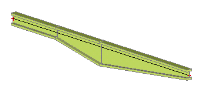Beam of a variable cross-section
SCIA Engineer allows the user to define a 1D member whose cross-section varies arbitrarily along the 1D member length.
1D member of arbitrarily variable cross-section can be divided into segments called spans. Each span has got specific properties that are absolutely independent on the properties of adjacent spans.
|
Coordinate definition |
Specifies whether individual spans will be defined in absolute or relative co-ordinates. See note below. |
|
Length |
Defines the length of the span. |
|
Type of cross-section |
Specifies how the cross-section of the span varies. |
|
Cross-section or cross-sections |
This option depends on the previous one. In general, it defines the cross-section of the span. |
|
Alignment |
The alignment is identical to the alignment of a haunch. |
Tip: The individual spans can be of different cross-section. And as material is a parameter of cross-section, it is possible that the individual spans are of different material.
Note: When spans are defined in absolute coordinates, one must be careful to "cover" the whole length of the 1D member. Otherwise, the "span-profiles" cover only part of the original length of the 1D member. Or, if the sum of the spans exceeds the length of the 1D member, spans overlapping the original length of the 1D member are ignored, in other words, the arbitrary beam is simply cut at the length of the original 1D member.
Type of cross-section
The cross-section of the span and its change can be defines in several ways.
|
Prismatic |
The cross-section of the span is constant. |
|
Parametric haunch |
A standard haunch is inserted into the span. |
|
Two cross-sections |
Two cross-sections corresponding to the two end-points of the span are defined. The cross-section varies over the span from one section to the other. |
Cross-section / Cross-sections
For prismatic cross-section, this item offers the selection of just one required cross-section.
For parametric haunch, two cross-sections must be specified. However, both of are based on one base cross-section. The user can specify parameters of the two end-sections. Each of the end-sections may be either identical with the base cross-section, or changes of the base cross-section dimensions can be specified.
If the "two cross-sections" option is chosen, the user just selects two end cross-sections.
Example
The 1D member defined in the property table above looks like:


